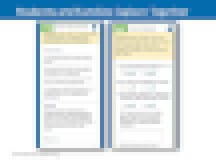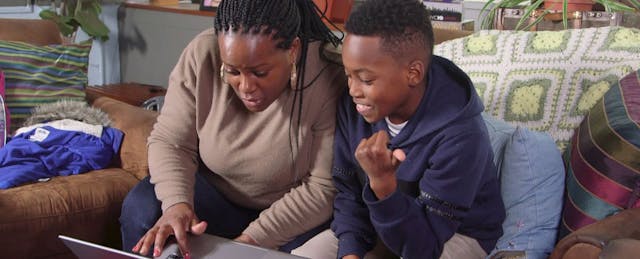Here’s a familiar conversation loop, one that gets replayed endlessly in homes across the country:
“How was school today?”
“Um, okay.”
Sure, it reflects the age-old communications gulf between adults and kids. But it also represents an achingly missed opportunity—a chance to involve parents in what their children are learning. And boosting that engagement can be a key part of unlocking student success.
For the past 18 months, a pilot program in a South Bronx public school, called “Family Playlists,” developed by the New York-based nonprofit, PowerMyLearning, has used technology to increase families’ involvement in their students’ learning. So far, the experience has been compelling. “Parents are learning at home, learning with their child, in the privacy and safety of their home,” observes Alan Baer, an assistant principal at South Bronx Preparatory. Of the 100 students participating in the pilot that began last January, 91 percent of families participated; of those, 84 percent submitted optional feedback, amounting to more than 300 personal messages to teachers last spring. Baer described the involvement of the families as “fantastic.”
“Having families deeply involved in what their kids are doing in class really matters,” says Elisabeth Stock, chief executive of PowerMyLearning. And by “deeply involved,” Stock means more than just asking about the day or becoming a super-power nagger. She means inviting students to teach their families what they’re learning in school.
Researchers have long known that active parental involvement in students’ learning can help them stay engaged and ultimately improve their performance. Over the past five years, several popular edtech companies have sprung up to better link schools and families. For instance, Remind makes it possible for teachers to let families know what assignments or tests students have coming up. ClassDojo aims to let teachers (and kids as well) send comments on student work directly to families. Kinvolved keeps parents up-to-date on their student’s attendance. Kaymbu helps teachers, particularly in early grades, share snapshots of student work and learning with families.
Yet too frequently, those communications channels become largely one-way megaphones for teachers, who then nudge parents into prodding students to finish upcoming assignments or study for the next test. Designing work that can potentially involve parents in more substantive ways can be much trickier.
Joyce Epstein, a researcher at Johns Hopkins University and the founder of the Hopkins-based National Network of Partnership Schools, has devoted years to honing a program called TIPS, or Teachers Involve Parents in Schoolwork. The idea behind TIPs is to create a systematic style of homework assignments that requires students to teach or share their work with their families.
That approach resonated well with PowerMyLearning, which Stock started in 1999. She based the program on the belief that learning happens best when supported by a triangle of strong relationships between teachers, students and families. Even so, more than 15 years into this effort, she conceded that her organization hadn’t done enough to support families.
“Families are overloaded. We hadn’t figured out how to support the base of those relationships, the one between teachers and families,” Stock says.
After extensively studying research on learning, Stock’s team pointed to the TIPS program as one of the most promising approaches—and set about working with Johns Hopkins to turn classic worksheets into a mobile-first digital program. They then approached teachers and administrators at South Bronx Prep, which already works closely with PowerMyLearning, to see if they were willing to try out the approach.
“We were a little nervous,” conceded Baer. “You can’t guarantee results. But PML [PowerMyLearning] has been a great partner with us for several years.” A sixth-grade math teacher, who is deeply dedicated to innovative learning practices, agreed to lead the effort. And the nonprofit stepped up by ensuring that there was a staff person on hand to coach involved teachers.

Here’s what a Family Playlist is: Once every week or two (often at the end of a unit), a teacher creates a homework assignment with two parts: First the student does an assignment, for instance, reviewing how to graph coordinates on a plane and answering multiple-choice questions. Next, the student sits down with a family member and teaches the lesson to them through a project, say, by creating a map of their neighborhood. The family member must answer a few yes or no questions about whether the student understands the assignment before it can be submitted to the teacher. All the work happens via mobile devices.
Even so, there was no guarantee that parents would engage with it. More than 95 percent of the students at South Bronx Prep qualify for free or reduced lunch. Parents and guardians frequently work multiple jobs, are uncomfortable speaking English and some may even be nervous or distrustful of interacting with teachers.
That kind of environment has led at least one struggling Colorado school district to propose abandoning parent-teacher conferences, according to a recent article in The Atlantic. By contrast, the Family Playlist approach aims to dial up the communication between families and educators.
And so far, Stock says, the response has been stunning.
In addition to answering the yes/no questions, the Family Playlist offered family members an “open response” section where they could share observations or comments. Stock says that her team figured few parents would use the option. To their astonishment, families flooded the channel with comments. “More than 84 percent of the participating families wrote at least one comment,” Stock reports. “And their writing is filled with emotion. It’s amazing stuff. The principal told us it was almost as if families had come out of hiding.”
This year, South Bronx Prep has rolled out Family Playlists in both sixth- and seventh-grade math classes, involving 180 students. Teachers choose to participate. “The teachers realize it’s not being mandated—and that they’re supported with a coach,” Baer emphasizes. As a result, “teachers are incorporating it into their lesson plans and making it their own.” Other schools are using Family Playlists, too, in cities that include Atlanta, Los Angeles, San Jose and Washington, DC, bringing the number of students using the program to around 800 this school year. (Here’s a case study with more details.)
PowerMyLearning, meanwhile, is building a library of supporting materials so that teachers can either create their own Family Playlist assignments or tap into existing ones. The materials, currently geared to grades 3 through 8, are available in Spanish and English. (Other languages are on the way, Stock says, as are materials designed to reach younger students.) And the nonprofit has taking the Playlist program out of “beta”and wrapped it into its premium PowerMyLearning Connect program, which includes curated playlists of curriculum. The nonprofit makes its platform available to schools for an annual fee that ranges from $2900 to $4900 per school.
“The Family Playlist is bringing families back into learning,” Baer says, by engaging parents and guardians in the security of their own homes. It’s too early, he notes, to say exactly what affect Playlists will have. But so far, teachers, parents and students are finding Playlists engaging and continuing to use them.
And not only will adults find they have more to ask their students about their learning—the students will have a chance to see how much their families are learning, too.
PowerMyLearning: A Glimpse Into Our Work from PowerMyLearning on Vimeo.


